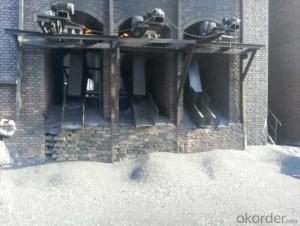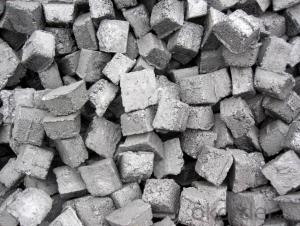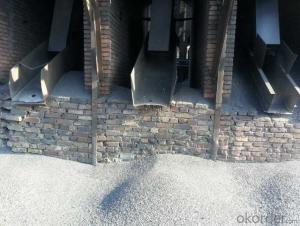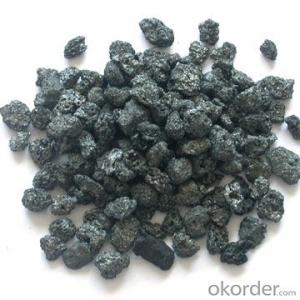Calcined Anthracite FC82-90 Made From Taixi Anthracite
- Loading Port:
- Lianyungang
- Payment Terms:
- TT OR LC
- Min Order Qty:
- 20 m.t.
- Supply Capability:
- 3500 m.t./month
OKorder Service Pledge
OKorder Financial Service
You Might Also Like
Calcined Anthracite FC82-90
Packaging & Delivery
25kgs/50kgs/1ton per bag or as buyer's request
Features
Calcined Anthracite
Fixed carbon: 90%-95%
S: 0.5% max
Size: 0-3. 3-5.3-15 or as request
It used the high quality anthracite as raw materials through high temperature calcined at over 2000 by the DC electric calciner with results in eliminating the moisture and volatile matter from anthracite efficiently, improving the density and the electric conductivity and strengthening the mechanical strength and anti-oxidation. It has good characteristics with low ash, low resistvity, low sulphur, high carbon and high density. It is the best material for high quality carbon products.
Advantage and competitive of caclined anthracite
1. strong supply capability
2. fast transportation
3. lower and reasonable price for your reference
4.low sulphur, low ash
5.fixed carbon:95% -90%
6..sulphur:lower than 0.3%
General Specification of Calcined Anthracite
| FC | 95 | 94 | 93 | 92 | 90 |
| ASH | 4 | 5 | 6 | 6.5 | 8.5 |
| V.M. | 1 | 1 | 1 | 1.5 | 1.5 |
| S | 0.3 | 0.3 | 0.3 | 0.35 | 0.35 |
| MOISTURE | 0.5 | 0.5 | 0.5 | 0.5 | 0.5 |
Pictures
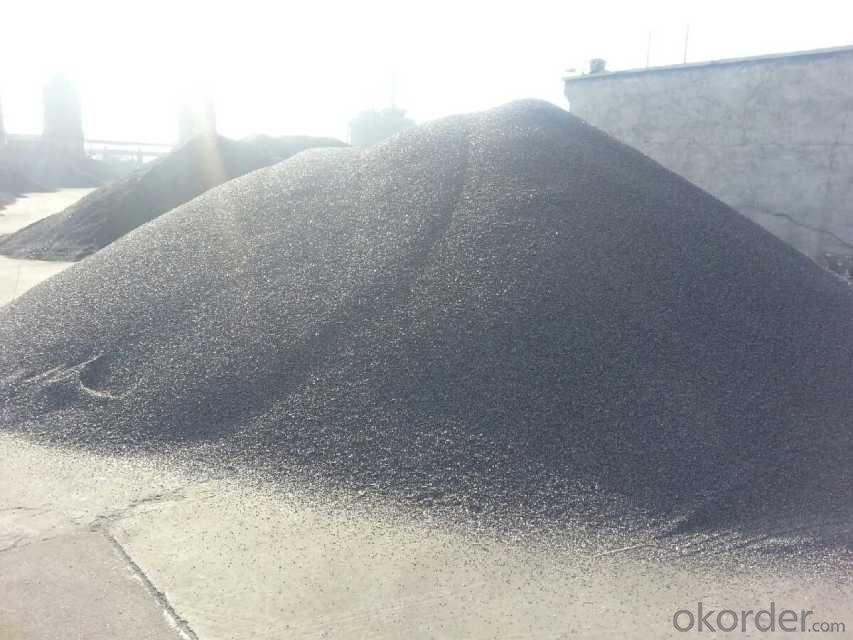
- Q:Power plant water treatment plant, there is a carbon removal device, the expert pointing out what the principle is it?
- The water enters from the upper part of the carbon removing device and is poured down by the water distribution equipment and enters the water tank from the lower part through the filling layer. In addition to carbon, due to the blocking effect of filler, flow down from the top of the water is dispersed into many small stocks or drop, from the bottom of the drum into the air and water contact area is very large, and the partial pressure of carbon dioxide in the air is very low, so it will come out from the water desorption carbon dioxide quickly away. Water can be removed by blowing carbon, which can reduce the carbon dioxide content to below 5mg/L. In fact, the simple point is that the amount of dissolved gas in water is proportional to the pressure of the air he touches. This principle is similar to the principle of the atmospheric Deaerator in the power plant. I hope I can help you
- Q:A carbon Roast Lamb Leg stores need to how much money
- You buy yourself a Roasted Whole Lamb furnace, generally in the 2600-3000 Roasted Whole Lamb Roast Lamb Leg can fix, baking method will provide. Can buy Roasted Whole Lamb furnace Ji'nan Thebaud Hardware Products Co. Ltd.
- Q:What does carbon burning mean?
- Put the burning carbon under the iron plate and make a copy of it on the iron plate, that is, carbon burning!
- Q:What are the effects of carbon emissions on human respiratory health?
- Human respiratory health can be significantly affected by carbon emissions. Carbon dioxide (CO2) is a primary component of carbon emissions and contributes to both air pollution and climate change. The presence of high levels of carbon dioxide in the atmosphere can result in the concentration of other pollutants like nitrogen oxides, sulfur dioxide, and particulate matter increasing. Exposure to these pollutants, particularly fine particulate matter (PM2.5), has been associated with various respiratory issues. Inhaling PM2.5 can cause irritation in the airways, leading to symptoms such as coughing, wheezing, and breathlessness. It can also worsen existing respiratory conditions like asthma, chronic obstructive pulmonary disease (COPD), and bronchitis. Long-term exposure to elevated levels of PM2.5 has been linked to the development of respiratory diseases and can contribute to higher hospital admissions and mortality rates. Moreover, carbon emissions contribute to the creation of ground-level ozone, a harmful pollutant that plays a significant role in smog formation. Ozone can cause inflammation and damage to the respiratory system, resulting in respiratory symptoms and reduced lung function. It can also aggravate pre-existing respiratory conditions and increase the susceptibility to respiratory infections. Apart from these direct effects, carbon emissions also contribute to climate change, which indirectly impacts respiratory health. Climate change can lead to more frequent heatwaves and extreme weather events, which can worsen air quality and trigger respiratory symptoms. It can also alter the distribution of allergens like pollen, mold spores, and dust mites, thereby increasing the prevalence of respiratory allergies and asthma. Overall, carbon emissions have substantial adverse effects on human respiratory health. They contribute to air pollution, which can cause respiratory symptoms, worsen existing respiratory conditions, and elevate the risk of developing respiratory diseases. Additionally, they contribute to climate change, which indirectly affects respiratory health by influencing air quality and the prevalence of allergens. Therefore, reducing carbon emissions and improving air quality are vital for safeguarding and promoting respiratory health.
- Q:How does carbon impact the prevalence of cyclones?
- Carbon emissions and the subsequent increase in atmospheric carbon dioxide levels have a significant impact on the prevalence of cyclones. Cyclones, also known as hurricanes or typhoons, are powerful and destructive weather phenomena that form over warm ocean waters. The increased carbon in the atmosphere, primarily due to human activities such as burning fossil fuels, leads to global warming and alters the climate patterns. Warmer ocean temperatures caused by carbon emissions provide the necessary fuel for cyclones to form and intensify. As carbon dioxide traps heat in the atmosphere, it warms the surface of the oceans, creating a favorable environment for cyclone development. The warmer the ocean waters, the more energy is available for cyclones to grow and become more destructive. Additionally, carbon emissions contribute to the changing climate patterns, leading to shifts in atmospheric circulation patterns. These changes can influence the frequency, intensity, and track of cyclones. While it is difficult to attribute individual cyclones to carbon emissions, scientific studies show that the overall increase in carbon dioxide levels is contributing to a greater number of severe cyclones in certain regions. Furthermore, the rising sea levels associated with global warming and carbon emissions can exacerbate the impact of cyclones. Higher sea levels lead to increased storm surge, which is the abnormal rise in water level during a cyclone. This storm surge can cause devastating flooding in coastal areas and result in significant damage to infrastructure and loss of life. In conclusion, carbon emissions have a profound impact on the prevalence of cyclones. The increased atmospheric carbon dioxide levels contribute to warmer ocean temperatures, creating a more favorable environment for cyclone formation and intensification. Changes in climate patterns due to carbon emissions also affect the frequency and track of cyclones. Additionally, rising sea levels associated with global warming can worsen the impact of cyclones through increased storm surge. It is crucial for society to address carbon emissions and work towards sustainable solutions to mitigate the impacts of cyclones and other severe weather events.
- Q:What are the consequences of increased carbon emissions on cultural heritage sites?
- Increased carbon emissions can have significant consequences on cultural heritage sites. One of the most immediate and visible impacts is the deterioration of physical structures and artifacts. Carbon emissions contribute to air pollution, which can result in the formation of acid rain. Acid rain contains high levels of sulfuric and nitric acids that can corrode and erode materials such as stone, metal, and paint. This can lead to the degradation and discoloration of historic buildings, monuments, and sculptures. Furthermore, carbon emissions contribute to climate change, resulting in more frequent and severe weather events such as hurricanes, floods, and wildfires. These extreme weather events pose a direct threat to cultural heritage sites, causing physical damage and destruction. For example, rising sea levels due to climate change can lead to the erosion of coastal archaeological sites, causing the loss of valuable historical artifacts and structures. In addition to the physical impacts, increased carbon emissions also pose a threat to the intangible aspects of cultural heritage. Climate change disrupts ecosystems and biodiversity, affecting the natural surroundings of cultural sites. This can lead to the loss of traditional knowledge, practices, and cultural landscapes that are closely linked to the heritage sites. Indigenous communities, for instance, may lose their ancestral lands and sacred sites due to changing environmental conditions. Moreover, cultural heritage sites often rely on tourism as a source of income and conservation funding. However, increased carbon emissions contribute to global warming, which in turn can lead to changes in travel patterns and preferences. This can result in a decline in tourist visits to cultural heritage sites, impacting local economies and hindering conservation efforts. Overall, the consequences of increased carbon emissions on cultural heritage sites are multi-faceted and wide-ranging. It is crucial to address and mitigate these emissions through sustainable practices and policies to protect and preserve our shared cultural heritage for future generations.
- Q:What is carbon PC?
- Polycarbonate (PC), polycarbonate is a molecular chain containing [O-R-O-CO] chain thermoplastic resin according to the molecular structure of the ester can be divided into aliphatic, alicyclic and aromatic type of fat, which has the practical value of the aromatic polycarbonate, and bisphenol A polycarbonate as the most important, molecular weight is usually 3-10 million.Polycarbonate, English Polycarbonate, referred to as PC.PC is a kind of amorphous, odorless, non-toxic, highly transparent colorless or slightly yellow thermoplastic engineering plastics, has excellent physical and mechanical properties, especially excellent shock resistance, tensile strength, bending strength, compressive strength and high creep; small size is stable; good heat resistance and low temperature resistance, mechanical properties, stability in a wide range of temperature dimensional stability, electrical properties and flame retardant properties, can be used for a long time at -60~120 deg.c; no obvious melting point, a molten state at 220-230 DEG C; the molecular chain rigidity, melt viscosity and high water absorption resin; small, small shrinkage, high precision, good dimensional stability, permeability of films is small; self extinguishing materials; stable to light, but not UV resistance, good weather resistance; oil resistance, acid and alkali resistance, no oxygen acid and amine, Ketones are soluble in chlorinated hydrocarbons and aromatic solvents. They are easy to cause hydrolysis and cracking in water for a long time. Because of their poor fatigue resistance, they are prone to stress cracking, poor solvent resistance and poor wear resistance
- Q:What is carbon steel, carbon manganese steel?
- Compared with other kinds of steel, carbon steel is the earliest, low cost, wide performance range and the largest amount. For nominal pressure PN is less than or equal to 32.0MPa, temperature of -30-425 water, steam, air, hydrogen, ammonia, nitrogen and petroleum products such as medium. Commonly used grades are WC1, WCB, ZG25 and high quality steel 20, 25, 30 and low-alloy structural steel 16Mn
- Q:Does anyone know what the definition of carbon storage is in ecology? Thank you
- It's not 12g's problem, it's carbon selection.If oxygen is selected, it is not 12g, but it must be 16g.So why choose carbon atoms instead of other atoms?(Note: this carbon atom must have 6 protons and 6 neutrons. The following is called C-12. Of course, there are 6 protons and 7 neutrons, or 8 neutrons carbon atoms, but can not be usedI refer to other information stored on the computer, but I can't remember the source.The reason why C-12 is used as the relative atomic mass standards are as follows: (1) the formation of many high quality carbon molecular ion and hydride, for mass spectrometry; (2) 12C is easily measured in a mass spectrometer, using mass spectrometer to determine the relative atomic mass is the most accurate method of modern (3); after using C-12, the relative atomic mass of all elements have little change, only 0.0043% less than in the past; (4) the carbon atom is stable in natural abundance; (5) the carbon in nature is widely distributed and its compounds especially organic compounds is various; (6) the minimum density of hydrogen is relative atomic mass not less than 1.The absolute mass of an atom is very small, and if expressed in kilograms, it is very inconvenient. Thus, 1/12, the quality of such a carbon atom, is used as a standard, and the mass of other atoms is the relative atomic mass of this atom
- Q:How does carbon dioxide affect the Earth's atmosphere?
- Carbon dioxide (CO2) affects the Earth's atmosphere in several ways. First and foremost, it is a greenhouse gas, meaning it traps heat from the sun and prevents it from escaping back into space. This process, known as the greenhouse effect, plays a vital role in maintaining Earth's temperature range and making our planet habitable. However, excessive amounts of CO2 in the atmosphere can intensify the greenhouse effect, leading to global warming and climate change. Human activities, such as burning fossil fuels for energy and deforestation, have significantly increased the concentration of CO2 in the atmosphere since the industrial revolution. The increased levels of CO2 contribute to the rising global temperatures, melting polar ice caps, and changing weather patterns. These changes have severe consequences, including more frequent and intense heatwaves, droughts, floods, and storms. Additionally, CO2 absorption by the oceans leads to ocean acidification, which harms marine life and coral reefs. Furthermore, the increase in CO2 levels affects ecosystems and biodiversity. Plants use CO2 during photosynthesis, but excessive amounts can disrupt their growth and alter the balance of ecosystems. This disruption can have cascading effects on other organisms that rely on the affected plant species for food or shelter. Overall, the excess of carbon dioxide in the Earth's atmosphere is contributing to significant environmental changes and poses a threat to the stability of our planet. It is crucial to reduce CO2 emissions, promote sustainable practices, and develop alternative energy sources to mitigate the impacts of climate change and preserve the health of our atmosphere.
1. Manufacturer Overview |
|
|---|---|
| Location | |
| Year Established | |
| Annual Output Value | |
| Main Markets | |
| Company Certifications | |
2. Manufacturer Certificates |
|
|---|---|
| a) Certification Name | |
| Range | |
| Reference | |
| Validity Period | |
3. Manufacturer Capability |
|
|---|---|
| a)Trade Capacity | |
| Nearest Port | |
| Export Percentage | |
| No.of Employees in Trade Department | |
| Language Spoken: | |
| b)Factory Information | |
| Factory Size: | |
| No. of Production Lines | |
| Contract Manufacturing | |
| Product Price Range | |
Send your message to us
Calcined Anthracite FC82-90 Made From Taixi Anthracite
- Loading Port:
- Lianyungang
- Payment Terms:
- TT OR LC
- Min Order Qty:
- 20 m.t.
- Supply Capability:
- 3500 m.t./month
OKorder Service Pledge
OKorder Financial Service
Similar products
New products
Hot products
Hot Searches
